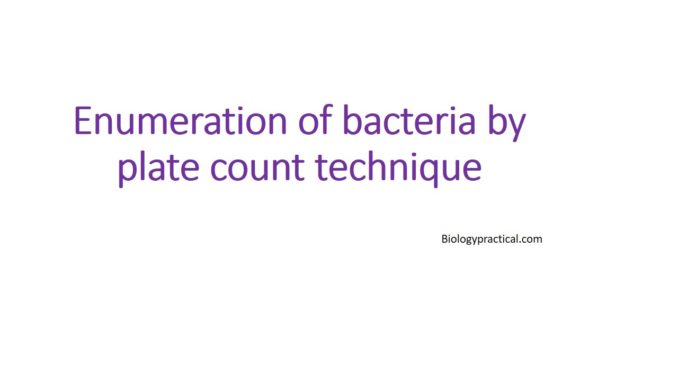
Principle:
- There are various techniques/methodologies for the enumeration (counting) of bacteria in a given sample. A viable cell count permits to detect the number of actively dividing cells in a sample. The plate count method is one of the most commonly used procedure as it allows the enumeration of viable cells. The plate count method depends on bacteria forming a colony on a nutrient medium. The colony becomes distinct and is observable to the naked eye, now the number of colonies formed on a plate can be counted. The principle of this technique is that ‘when material containing bacteria is cultured, every viable bacterium develops into a visible colony on a nutrient agar medium’. The number of colonies, thus, is same as the number of the organisms present in the sample. For the effective result, the dilution of original sample must be performed so that on average between 30-300 colonies of the target bacterium are grown. Less than 30 colonies make elucidation a bit flawed and more than 300 colonies often leads to overlapping and errors in counting.
- In this procedure, a small measured volume (or weight) is merged with a large volume of sterile water or saline called the dilution blank (or diluent). Dilutions are often prepared in multiples of ten.
- A single dilution can be calculated as:
- Dilution = Volume of the sample/ Total volume of the sample and the diluent
- The laboratory procedure includes making serial dilutions of the sample (1:10, 1:100, 1:1000 and so on) in distilled water by transferring a known volume of the dilution to second dilution blank and so on. Once diluted, the specific volume of the dilution sample (1ml or 0.1ml) from various dilutions is added to sterile Petri plates (In triplicate for each dilution) to which molten and cooled (45-50°C) suitable agar medium is added. Quebec colony counter is used to count the colonies. The number of the organisms developed on the plates after an incubation period of 24-48 hrs per ml is obtained by multiplying the no. of colonies obtained per plate by the dilution factor, which is the reciprocal of the dilution. The dilution is written in exponential notation to aid calculations (e.g. 10-3).
- Number of cells/ml=
(Number of colonies)/(Amount plated ×dilution)
Requirements:
- Sample or bacterial suspension
- 9 ml dilution blanks
- Sterile 1 ml pipettes
- Colony counter
- Sterile Petriplates
- Nutrient agar medium

Procedure:
- Label the dilution blanks as 10-1, 10-2, 10-3, 10-4, 10-5, 10-6and 10-7.
- Prepare the initial dilution by adding 1ml or 1 g of the sample into a 9ml dilution blank labelled 10-1 thus diluting the original sample 10 times (1/10 and is written as 10-1 or 1:10).
- Mix the contents by rolling the tube back and forth between your hands to obtain uniform distribution of organisms (cells).
- From the first dilution, transfer 1 ml of suspension while in motion, to the dilution blank 10-2 with a sterile and fresh 1ml pipette diluting the original specimen/ suspension to 100 times (1/100 or 10-2).
- From the 10-2 suspension, transfer 1ml of suspension to 10-3 dilution blank with a fresh sterile pipette, thus diluting the original sample to 1000 times (10-3).
- Repeat this procedure till the original sample has been diluted 10-7times by using a fresh sterile pipette each time.
- From the appropriate dilutions (10-1 to 10-7) transfer 1ml or 0.1ml of suspension while in motion, with the respective pipettes, to sterile Petri dishes. Three Petri dishes are to be used for each dilution.
- Add approximately 15ml of the nutrient medium, melted and cooled to 45°C, to each Petri plate containing the diluted sample. Mix the contents of each plate by rotating gently to distribute the cells throughout the medium.
- Allow the plates to solidify.
- Incubate these plates in an inverted position for 24-48 hours at 37°C.
Observations:
- Observe all the plates for the appearance of bacterial colonies.
- Count the number of colonies in the plates, that have colonies in the 30-300 range, by placing each plate one by one on the platform of a Quebec colony counter.
Results interpretation:
- Calculate the number of bacteria per ml of the original suspension/sample as follows:
- Organisms per milliliter/ gram of the sample =
(Number of colonies (average of 3 replicates))/(Amount plated ×dilution)
- For instance, if 50 colonies were counted on a 10-5dilution, then
- Number of cells/ml=
50/(1ml ×1/100000) = 5000000
- =5 x 106 bacteria/ml or gram of sample
